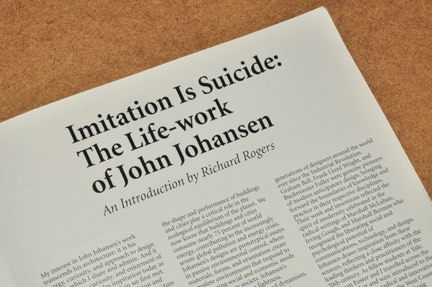RICHARD ROGERS COMMENTARY
INFLUENCE ON POMPIDOU DESIGN
His buildings celebrate ad-hocism, improvisation, and change rather than acting as static monuments to an inflexible society: a notion which strongly influenced our design approach to the Pompidou Centre back in the early 1970s. In this respect, Johansen's architecture-like the more graphic but mainly unbuilt work of Archigram and Cedric Price's cybernetic experiments of the 1960s demonstrates the full architectural and social potential of technology and science. The paradigmatic shift from objects to relationships that has characterized the late 20th century is synthesized in Johansen's work.
The confident use of geometry in the U.S. Embassy in Dublin and the Goddard Library, the organic shapes of the Mummers Theater and the L. Frances Smith School, with expressed functional volumes linked by limb-like connecting rods, and the more experimental exercises for adaptable theatres and exhibition structures, serpentine levitators and metamorphic capsules add up to a formidable body of work.
When I arrived in the USA in 1961 I was stunned and inspired by the New World; its scale, its energy, the excitement of the restless search for tomorrow. After fifty years in practice, Johansen still believes in the art of that which is "not yet possible but theoretically realistic," developing new projects for the 21st century.
Imitation Is Suicide:
The Life-Work of John Johansen
by Richard Rogers (1933 - ), noted British architect
from John M Johansen: A Life in the Continuum of Modern Architecture by John M Johansen, published by l'Arca Edizioni
My interest in John Johansen's work transcends his architecture: it is his energy, curiosity, and approach to design and life which I share and admire. And it is this energy, curiosity, and enjoyment of life that still provides inspiration today as it did thirty years ago when we first met. When I consider the lack of vision and inventiveness of most current architecture in America, I am reminded of the period of intense creativity, innovation, and research (that has all but disappeared) synthesized by John Johansen's career. Johansen's work has spanned five decades of American history, a period that has seen the architectural pendulum swing from modernism to postmodernism, and back again.
Throughout his career his architecture has demonstrated a rare consistency, transcending experimentation in a range of formal languages: from early experiments in neoclassicism and biomorphism to successive waves of conventional modernism, organicism, and deformed geometries. His buildings are equally informed by the organising principles of biotechnology and electromagnetics as they are by conventional functional requirements, confirming that design is an indeterminate science: a theoretical as well as an aesthetic process.
His conversations with Marshall McLuhan, for example, directed him towards a deep understanding of the potential of computers as intellectual structuring devices that have influenced the shape and organisation of his buildings. The analogy between the basic organisation of electronic circuits and architecture is original and enlightening.
Website Copyright © 2011 John M Johansen All Rights Reserved
No information, photos, videos or audio on this website may be distributed, copied
or otherwise used without the written permission of John M Johansen or his representative
Website created by John Veltri and Marguerite Lorimer EarthAlive Communications www.earthalive.com
Please direct inquires to info@earthalive.com


Richard Rogers in NYC November 2010









On the East coast, the more muscular and expressive work of John Johansen and Paul Rudolph revealed a similar passion for originality and experimentation which has had a lasting impression on my own work. Returning to Britain to set up our first architectural practice (Team 4) comprising of Norman and Wendy Foster, Su Rogers and myself, we realised the importance of the American experience, where the architect is a genuine problem-solver rather than a mere stylist. We understood that the traditional European approach, constrained by cultural and formal conventions, could never meet the needs of a changing society that we were going to try to serve.
In this respect Johansen provided a model of holistic, multidisciplinary design, where architectural form is determined by a range of cultural, social, psychological, economic, environmental, and technological issues - that has strongly influenced my own approach to the theory and practice of architecture. Johansen's work reminds us that good architecture results as much from an understanding of the world as it does from its internal rules and principles










 |

Scroll Down for Video

















FOUR PRINCIPLE ELEMENTS
He identifies the four principal elements of design as the chassis (structural frame), the “components" (functional elements), the “subcomponents" (servant spaces), and “harnesses" (flow of information). It is this underlying structuring logic that gives a sense of clarity and precision to his buildings, regardless of their formal language or style or building on Buckminster Fuller's pioneering work of the 1920s and 1930s, Johansen was one of the first established architects in the USA to recognise the significance of the environmental impact of architecture. He understood, well before it became fashionable to do so, that the shape and performance of buildings and cities playa critical role in the ecological equilibrium of the planet. We now know that buildings and cities consume nearly 75 percent of world energy, contributing to the increasingly severe global pollution and energy crisis. Johansen's designs are prototypical essays in passive environmental control, where materials, forms, and orientation create complete environments that respond to the changing social and economic needs of contemporary society. Johansen's architecture thrives on lightness, movement, transparency, and dynamism.
His architecture reveals the presence of a lively, enquiring mind of a natural researcher: never content with the solutions of the past and the present, always looking to the promise of the generations of designers around the world ever since the Industrial Revolution. Graham Bell, Frank Lloyd Wright, and Buckminster Fuller were genuine pioneers of modern anticipatory design, bringing forward the boundaries of knowledge and practice in their respective disciplines.
LASTING IMPRESSION
Their work and inventions reflected the spirit of modernity celebrated in the radical writings of Marshall McLuhan, Irving Gough, and Marshall Berman who recognised the liberating social and psychological potential of communications technology and design. Johansen draws inspiration from these sources, reflecting a close affinity with the leading thinkers and practitioners of the 20th century. As fellow students at Yale, Norman Foster and I travelled across the USA together and were introduced to the work of the most radical and innovative architects operating in the west coast: Frank Lloyd Wright, Bucky, Craig Ellwood, Charles Eames, and many other architects who reinterpreted the European modernist tradition in the relative neutrality of the American context.